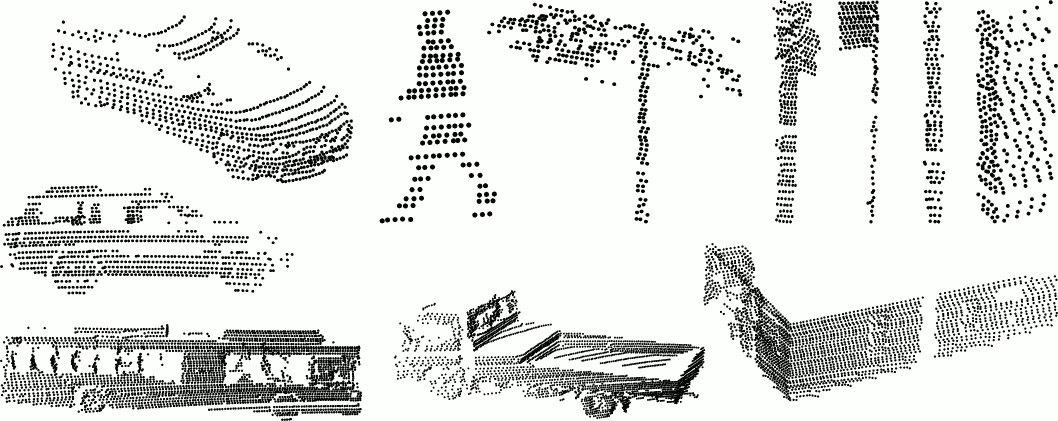Sydney Urban Objects Dataset
(formerly objects4)
Collected by Alastair Quadros, James Underwood, Bertrand Douillard; 2013

This dataset contains a variety of common urban road objects scanned with a Velodyne HDL-64E LIDAR, collected in the CBD of Sydney, Australia. There are 631 individual scans of objects across classes of vehicles, pedestrians, signs and trees.
It was collected in order to test matching and classification algorithms. It aims to provide non-ideal sensing conditions that are representative of practical urban sensing systems, with a large variability in viewpoint and occlusion.
This dataset is used in the following publications:
M. De Deuge, A. Quadros, C. Hung, B. Douillard. Unsupervised Feature Learning for Classification of Outdoor 3D Scans. In Australasian Conference on Robotics and Automation (ACRA), 2013.
A. Quadros. Representing 3D Shape in Sparse Range Images for Urban Object Classification. PhD thesis, The University of Sydney, 2013.
Download
| Sydney Urban Objects Dataset |
Software
The ACFR has developed two open-source libraries you may find useful.
- comma (https://github.com/acfr/comma/wiki), for processing binary-csv data.
- snark (https://github.com/acfr/snark/wiki), for visualising point clouds,
and converting from raw velodyne data format.
Reading the data
Each object is available in 3 formats. The simplest to read is ascii csv
format (objects/*.csv). A more compact and faster-to-process format is binary
csv (objects/*.bin). These both have the same fields, described in the *.meta
files, which are all as follows:
| Field | Description | Format |
|---|---|---|
t |
Timestamp, microseconds since epoch |
int64 |
intensity |
Laser return intensity (0-255) |
uint8 |
id |
Laser id (the Velodyne has 64 lasers) |
uint8 |
x,y,z |
3D point |
float32 x3 |
azimuth |
Horizontal azimuth angle, radians, calibration-corrected |
float32 |
range |
Range (m) of laser return, calibration-corrected |
float32 |
pid |
Point id of the original, full 360deg scan |
int32 |
An example python script for loading the binary data is given in read-bin.py.
You can also convert binary csv to ascii csv format using 'comma', in a \*nix
terminal (or cygwin for Windows users):
cat objects/excavator.0.10974.bin | \
csv-from-bin "t,ub,ub,f,f,f,f,f,i" > excavator.0.10974.csv
With 'snark', you can display the points:
cat objects/excavator.0.10974.bin | \
view-points –binary "t,ub,ub,f,f,f,f,f,i" –fields t,,,x,y,z
Scans
In addition to the individual objects, the full 360deg scans are also provided, as the original velodyne data packets. Each object is named by:
[class].[instance].[scan]
For example, the segmented excavator is in 'objects/excavator.0.10974.bin', and the full 360deg scan that contains the excavator is in 'scans/scan.10974.bin'. The field 'pid' indicates which points in the full scan are from the excavator.
The 'full scan' data are stored in the raw Velodyne format (8 byte timestamp in microseconds + 1206 byte packet, see the Velodyne manual (http://www.velodynelidar.com/). You can read this data using snark's 'velodyne-to-csv' application. The calibration parameters for our Velodyne are in the file: db.xml.
Classes
Only the most populous classes were used for testing classification algorithms.
A set of 588 objects was selected from the full 631, split evenly
into 4 folds. See 'folds/folds*.txt' for the objects in each fold. Folds were
selected to ensure no object appeared in two folds (some objects appear more
than once in the dataset, scanned from different positions). This set still
contains many challenging instances of highly occluded objects.
| Class | Instances |
|---|---|
4wd |
21 |
bench |
2 |
bicycle |
8 |
biker |
4 |
building |
20 |
bus |
16 |
car |
88 |
cyclist |
3 |
excavator |
1 |
pedestrian |
152 |
pillar |
20 |
pole |
21 |
post |
8 |
scooter |
1 |
ticket_machine |
3 |
traffic_lights |
47 |
traffic_sign |
51 |
trailer |
1 |
trash |
5 |
tree |
34 |
truck |
12 |
trunk |
55 |
umbrella |
5 |
ute |
16 |
van |
35 |
vegetation |
2 |